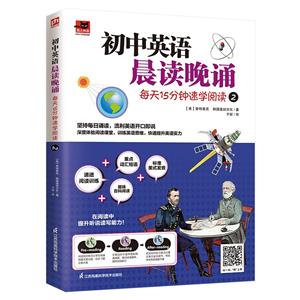-
>
世界经典文学名著系列注音版:小妇人(九品)
-
>
中考现代文阅读答题必备公式(备考2023)
-
>
作文指南--怎样描写
-
>
汉语大字典 袖珍本第二版
-
>
寂静的春天(文联平装全译本)
-
>
追随:中国打工子弟心灵笔记(签名本)
-
>
趣味科学丛书--趣味数学思考题
初中英语晨读晚诵 每天15分钟速学阅读2 版权信息
- ISBN:9787571326401
- 条形码:9787571326401 ; 978-7-5713-2640-1
- 装帧:一般胶版纸
- 册数:暂无
- 重量:暂无
- 所属分类:>>
初中英语晨读晚诵 每天15分钟速学阅读2 本书特色
1.趣味百科选材文章选材丰富,囊括历史、人文、科学、数学、语言、艺术等多个方面,学生学习英语的同时,还能了解各类趣味知识,拓展知识面。2.递进阅读训练每篇文章前后会有相应的阅读训练,还特别设置综合练习,帮助学生快速掌握阅读技巧,培养英语阅读思维能力。3.全彩趣味插图文章都配有与主题相关的彩图,使学生对主题和关键信息有更直观、深刻的理解。边看图边学百科知识,让阅读更加轻松有趣!4.附赠配套练习册本书附赠一本随堂练习册,便于学生随时学、随时练,及时复习巩固。5.外教朗读音频由专业外教录制的标准美音音频,扫码即可收听,使学生在阅读中同步提升听力、口语水平。
初中英语晨读晚诵 每天15分钟速学阅读2 内容简介
本书文章选材丰富,搭配精美彩图,汇集美国历史、我们的地球、运算和概率、英语中常见的错误、艺术的重生等主题的阅读材料。全书共分为21天的课程学习,每天课程内容由课前预习、文章阅读、课后练习构成,同时每章还特别设置综合练习。通过系统阅读训练可以帮助学生快速掌握阅读技巧,提高英语阅读能力。词汇是阅读的基础,书后附录单词表,收录阅读中的重要单词、短语,有助于学生积累词汇。每篇文章都配有音频,学生可以边听边读,不止是学阅读还能提升听力、口语水平。此外,随书附赠一本练习册,随学随练,学习效果加倍。
初中英语晨读晚诵 每天15分钟速学阅读2 目录
Day 01...3
History and Culture
Clues from the Past
Day 02...7
The American Government
Three Important American Documents
Day 03...11
The Election System of the United States
The American Presidential Election System
Day 04...15
The American Civil War
The Civil War
Day 05...19
Post-Civil War
Reconstruction
Day 06...23
The Nation Grows
Industrialization and Urbanization
Day 07...27
War and Revolution
The Age of Imperialism
Day 08...31
World War II
World War II
Wrap-Up Test 1...35
Chapter 2 Science
Day 09...39
Living Things and Their Environments
Interactions among Living Things
Day 10...43
How Do Ecosystems Change?
Biomes and Ecological Succession
Day 11...47
Earth's Surface
Earth's Changing Crust
Day 12...51
Earth's Atmosphere
What Makes Up the Atmosphere?
Day 13...55
The Properties and Structure of Matter
Atoms, Elements and Compounds
Day 14...59
Matter and How It Changes
Mixtures and Solutions
Day 15...63
The Human Body
The Stages of Growth in the Human Body
Wrap-Up Test 2...67
Chapter 3 Mathematics ?? Language ?? Visual Arts ?? Music
Day 16...71
Computation
The Order of Operations and Inverse Operations
Day 17...75
Probability and Statistics
Ratios, Percents and Probabilities
Day 18...79
Stories, Myths and Legends
Echo and Narcissus
Day 19...83
Learning about Language
Common Mistakes in English
Day 20...87
The Renaissance
The Rebirth of the Arts
Day 21...91
Musical Instructions
Italian for Composers
Wrap-Up Test 3...95
Answers and Translations...99
Word List...117
初中英语晨读晚诵 每天15分钟速学阅读2 节选
Day 01 History and Culture Visual Preview How do historians and archaeologists study the past? Historians often spend their time studying primary and secondary sources. Archaeologists examine artifacts and remains for clues about the past. Archaeologists visit ruins of ancient buildings to see how people used to live. Vocabulary Preview | Write the correct word next to its meaning. timeline archaeologist historian eyewitness artifact 1. _____: a person who studies history or the past 2. _____: a person who studies the remains of past human cultures 3. _____: a person who was present at an event 4. _____: a diagram of events arranged in order according to when they happened 5. _____: a man-made object from a past culture or civilization Clues from the Past History is the study of people, places and events from the past. We study history to learn about the past. Experts, such as historians and archaeologists, help us understand the past. To learn about life from long ago, they examine clues and records from people in the past. How do they do this? Historians use both primary sources and secondary sources. A primary source is material written at the time an event happened. It is often written by a person who was an eyewitness to the event. Primary sources can be books, diaries, reports, official documents and photographs. A secondary source is material written based on primary sources. Some historians also study oral history. This is a collection of stories that are told and passed down from one generation to the next. What happens when there is no record or written history left behind? That is where archaeologists are needed. They examine artifacts. These are man-made objects used by past civilizations. Historical artifacts include tools, pottery, clothes, jewelry and even paintings. Archaeologists also study human remains, such as bones and hair. There are many ruins of ancient buildings for them to study as well. All of these contribute to archaeologists learning how people lived in the past. Many historians often make timelines to list events in history. Timelines show the dates that various events occurred and let historians see the order of past events. On many timelines, there are sometimes the abbreviations B.C. and A.D. after dates. B.C. stands for “before Christ”. A.D. stands for “anno Domini”. That is Latin for “years after the birth of Christ”. Nowadays, historians have access to many modern technologies. This makes studying the past much easier. Many primary sources have been translated and published in books or on CD-ROMs. Other books, such as encyclopedias, almanacs and atlases provide much information, too. Studying the past has never been easier than today.
初中英语晨读晚诵 每天15分钟速学阅读2 作者简介
【美】普特莱克 毕业于美国塔夫茨大学,获得英语文学学士和历史学硕士学位。他撰写的多部英语学习类畅销书被众多学子鼎力推荐。 韩国逸创文化 编著ESL和EFL考试辅导资料的专业机构。 于妍 毕业于北京第二外国语学院,毕业后从事对外汉语教学以及翻译工作。译作有《献给青少年的西方文学史》《献给青少年的西方科学史》《朴炅美的数学》等。
- >
朝闻道
朝闻道
¥20.2¥23.8 - >
罗庸西南联大授课录
罗庸西南联大授课录
¥13.8¥32.0 - >
苦雨斋序跋文-周作人自编集
苦雨斋序跋文-周作人自编集
¥6.9¥16.0 - >
伯纳黛特,你要去哪(2021新版)
伯纳黛特,你要去哪(2021新版)
¥15.9¥49.8 - >
新文学天穹两巨星--鲁迅与胡适/红烛学术丛书(红烛学术丛书)
新文学天穹两巨星--鲁迅与胡适/红烛学术丛书(红烛学术丛书)
¥9.9¥23.0 - >
史学评论
史学评论
¥18.5¥42.0 - >
大红狗在马戏团-大红狗克里弗-助人
大红狗在马戏团-大红狗克里弗-助人
¥3.3¥10.0 - >
我从未如此眷恋人间
我从未如此眷恋人间
¥16.4¥49.8
-
初中英语满分作文
¥18.8¥29.8 -
超级初中数理化生公式定理随身备
¥16.1¥24.8 -
初中生作文精批精改
¥6.4¥20 -
和谐因此而美妙-语文报杯-(初中)(全国作文大赛十周年精华版)
¥8.5¥19.8 -
PhoenixEnglish凤凰英语分级阅读:第四级:过新年
¥17.6¥36



















